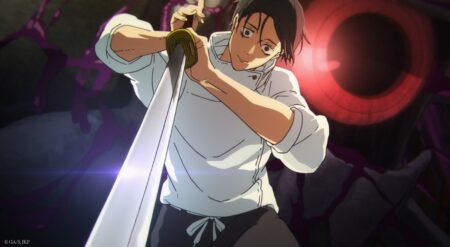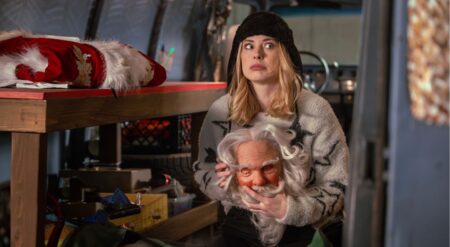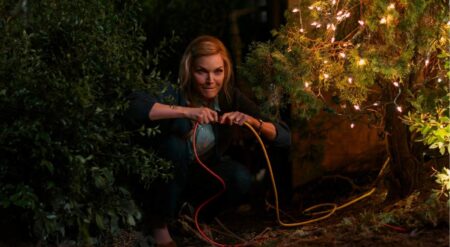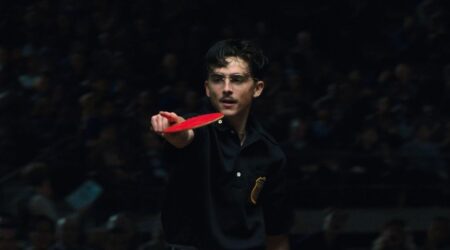Picking up immediately where Season 1 left off, DanDaDan Evil Eye wastes little time in reminding us of its intoxicating infectiousness. Based on the manga written and illustrated by Yukinobu Tatsu and produced by the consistently great Science Saru, the film, which comprises the first three episodes of Season 2, launches straight into the mayhem.
While Season 1 prioritized introducing our central, lovable duo as they faced all things alien and yōkai, the film quickly delves into the latest arrival with Jiji (Kaito Ishikawa/Aleks Le), as his story further expands a universe without limits.
DanDaDan Evil Eye picks up where Season 1 left off with Momo Ayase (Shion Wakayama/Abby Trott) cornered in a public hot spring while Okarun/Ken Takakura (Natsuki Hanae/A.J. Beckles) and Jiji learn that there’s more going on in the latter’s family home than meets the eye. While the Season 1 finale made us feel the threat of the men imposing themselves on Momo, the direction heightens it in Evil Eye, prompting a big release of held breath after her eventual escape.
The trio – along with a hilariously stowed away Turbo Granny (Mayumi Tanaka/Barbara Goodson) – have been sent to Jiji’s hot springs town home to solve the mystery of his parents, who are hospitalized due to some unnatural force possessing their house. However, while there, it’s not just all-powerful spirits that they encounter.
As a traditional movie, DanDaDan Evil Eye falters because, frankly, it isn’t one.

Instead, they discover the roots of evil, along with the domineering Kito family, which leads the charge in maintaining order, and how the two intersect, bearing insidious and grievous results. It’s not just that there’s evil lurking underneath the idyllic and tranquil town – it’s being actively fed by those who blindly support an unnamed being to keep their village “safe.”
While it’s become a frequent model for anime releases these days, slapping a title on three episodes doesn’t make a film. It’s an event, certainly, but there’s no missing the stitching of the three separate installments together, no more glaring than the abrupt end that marks a suitable cliffhanger. While the sheer quality is undeniable (it looks superb), it very clearly is operating on an episodic structure. Even if the OP isn’t playing at the top of the episode, the start and end times are apparent.
Co-directed by the returning Fuga Yamashiro and Abel Gongora (who directed the opening theme animation for Season 1), DanDaDan Evil Eye is positively breathtaking to behold from start to finish. The beauty and skill are not just found in the action (though it’s fantastic) but in the downtime and in-between moments as well.
The composition is gorgeous, following the trend of Season 1, which ensures realism and character-driven direction to guide the story. Despite the larger-than-life foes Momo and Okarun face, the series refuses to lose its sense of self or humanistic qualities. We’re grounded with the two even if their adversaries take to the stratosphere.
DanDaDan Evil Eye highlights what makes the anime stand apart.
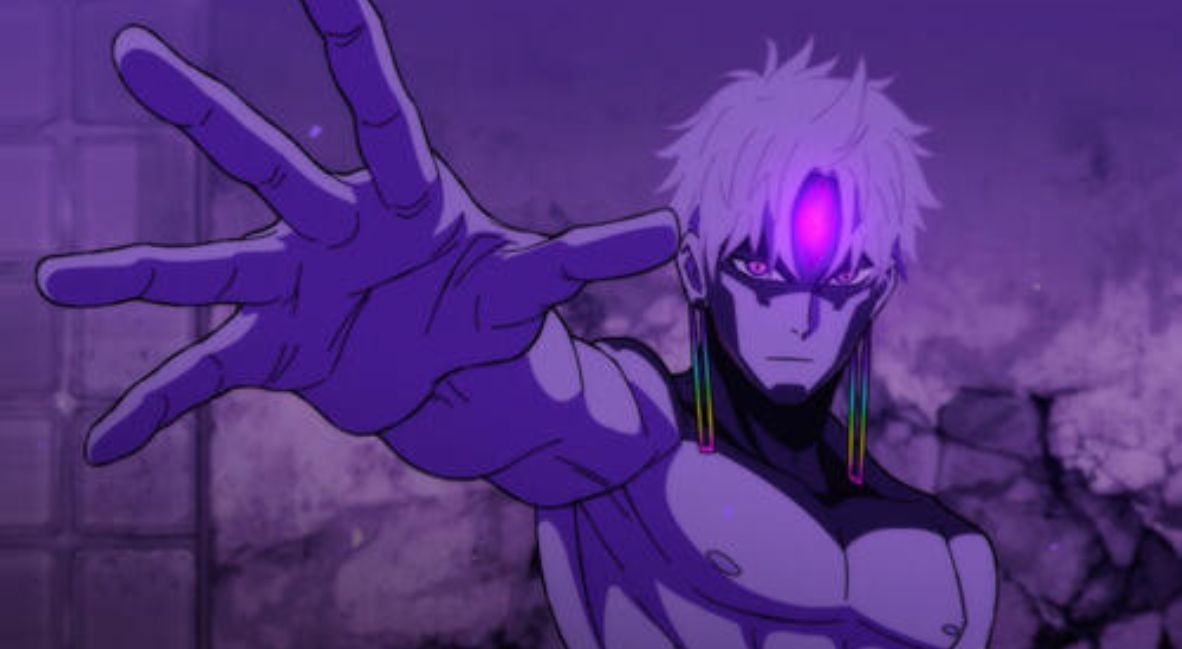
One aspect that the series (and Science Saru in general) excels at is ensuring that it doesn’t feel like any other anime. While certain beats and tropes mirror the very best of the best shonen series today, DanDaDan separates itself from the crowd. It vibrates with chaos and a specific brand of charm, aided by the direction that sets us at ground level as the world, as Momo and Okarun know it, crumbles and remakes itself. With an electrifying score composed by Kensuke Ushio, the series showcases a clear desire to be more than what we expect from shonen these days.
And it does so gleefully, as is evident in DanDaDan Evil Eye. The colors are immaculate, the world bleeding gratuitously with every frame, framed by reds, oranges, and purples in the most emotionally fraught moments. However, the series also finds moments of normality that showcase the more intricate and detailed artistry on display.
Scenes such as Momo and Turbo Granny walking through this small town offer tactile and lived-in frames that add greater depth and personality to the space they occupy. The detailed work in these more down-to-earth moments helps build the world around them.
And this is necessary for Evil Eye to give us something to hold onto beyond the main narrative itself as the trio tries to navigate it. But beyond the direction, artistry, and character designs, it’s the writing that shines through. It’s the same as it was with our introduction to Aira.
What begins as a shallow start transforms into something that becomes the nucleus of what DanDaDan is about: humans—beings—finding comfort, camaraderie, and healing through the efforts and companionship of others. Jiji might be shallow at first glance, but his kindness opens up endless avenues for the series to explore, especially with the Evil Eye character.
The character design for Jiji and the countless faces he pulls are animated wonderfully, but he comes into his own in this arc. Despite being a supporting character, he, like Aira, is pivotal to the series’ trajectory and immediately lovable. His journey in Evil Eye keeps us emotionally engaged as yet another backstory demonstrates the ongoing horrors of the world and how kindness and innocence can be warped into malevolent forces through the greed and violence of others.
Among the breakneck speed and humor, there’s undeniable heart.
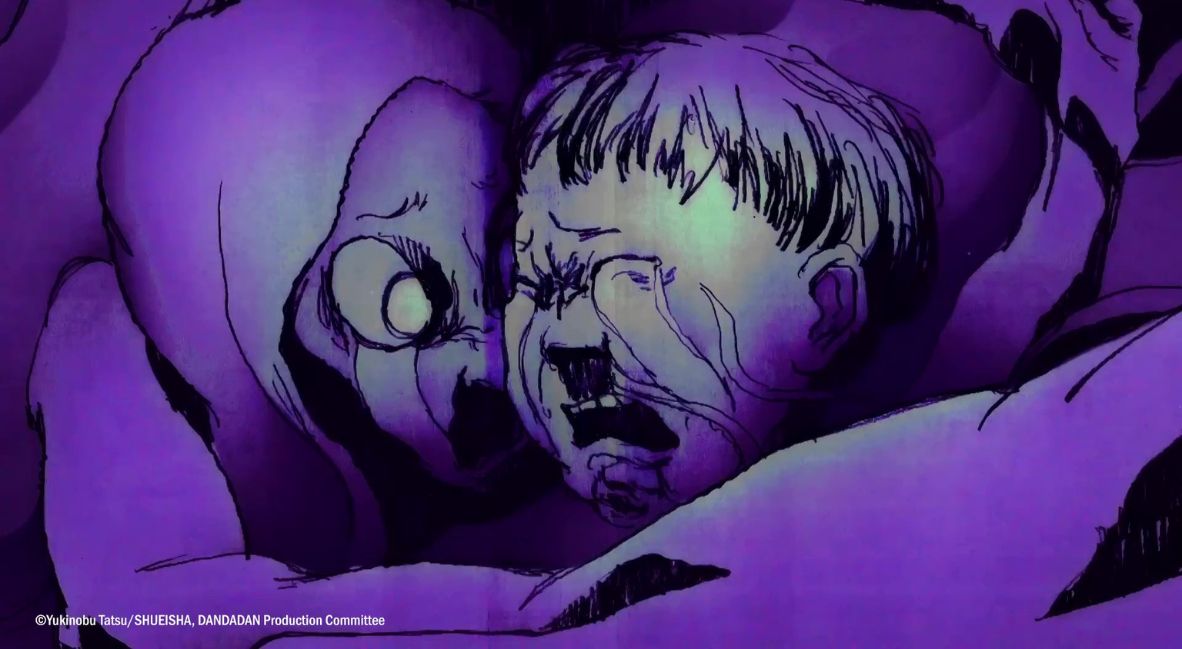
Not to suggest that all three episodes are overwhelmed by misery. There’s plenty of charm and levity, often found in the three’s dynamics and Turbo Granny’s observations. Okarun’s continuing stability in his yōkai form makes for instant hilarity because, as frequently as he is triumphant, he stumbles.
But it’s that marriage of tones and the balance the series finds in managing it that makes DanDanDan such a formidable entry. There’s such clear care in the writing and animation, with no corners cut or rushed artistry. Each frame is as strong as the next.
The only major fallback of DanDaDan Evil Eye is that, once again, Momo faces down sexual threats—this time from human men rather than aliens. The only thing that stops the sequence from echoing the unpleasantness of the premiere is the combination of her not being shot with such a leering lens and the threat of the Kito men being apparent. We’re meant to feel the danger rather than it being played off as a joke. Their grotesque forms and overbearing presence ensure that we know this is intended to cause discomfort rather than laughs.
DanDaDan Evil Eye instantly reminds us just why this series is so beloved while demonstrating how much we’ve yet to explore. Ending on yet another cliffhanger, the film sets the stage for Season 2 with its vibrant and kinetic animation, the impassioned and colorful voice acting, and a story that thrums with anticipation of the twists and turns the series is about to hurtle us into. Bombastic in the direction without ever forgoing the intimacy and character work at its core, DanDaDan Evil Eye relentlessly plunges us straight back into joyous madness.
DanDaDan Evil Eye arrives in theaters on June 6.
DanDaDan Evil Eye
-
Rating - 8.5/108.5/10
TL;DR
DanDaDan Evil Eye instantly reminds us just why this series is so beloved while demonstrating how much we’ve yet to explore. Bombastic in the direction without ever forgoing the intimacy and character work at its core, it relentlessly plunges us straight back into joyous madness.



